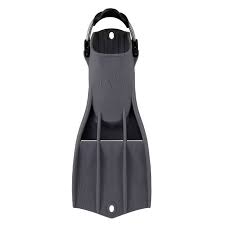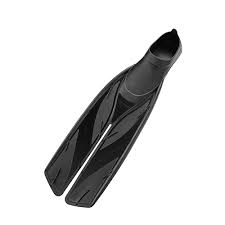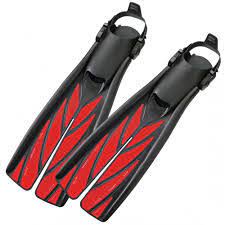When looking at a set of fins there are a number of factors to consider in order to make a properly informed decision. It is best to consider the type of diving you are doing, what conditions you frequently encounter, and therefore what features are most important for you.
The following paragraphs highlight some of the major considerations you may have to make along with some of the pros and cons of each feature.
Blade Type.
There are a variety of fin blades, all of which are designed with a variety of purposes in mind. Fins with a full blade are designed to be powerful, displacing large amounts of water to allow you to cover more ground for each kick cycle. Full fin blades also allow a diver to frog kick as well as flutter kick or Dolphin kick making them extremely versatile for a variety of conditions and uses. This is the most common blade shape for most divers.
Split fins are the other frequently encountered blade shape, where the fin is ‘split’ down the centre. These are based on Sea Lion flippers and have manoeuvrability in mind. As the fin blade is split in two, they do not displace as much water as a conventional blade so many will argue they lack power when kicking into strong currents. However, this means making small movements and adjustments is easier, aiding a diver to be more manoeuvrable. The split down the centre is great for people who have a difficult time using fins due to knee or ankle injuries as there is less resistance on each kick through the water.
Weight.
There is some variety in the weight of a fin. Heavier fins tend to have a stiffer blade and foot pocket, providing more power but also more work for your leg muscles. These fins are negatively buoyant so sink if left alone in the water. A heavier fin suits people wearing thicker booties, or with ‘floaty feet’ as it counteracts the positive buoyancy of that area. They are also helpful for dry-suit divers to counteract the air in their suits. For people with heavy feet, a heavy fin will tend to drag their feet towards the bottom making good trim difficult.
Fins also come in lighter weights. This means they tend to float in the water or are neutrally buoyant which can be beneficial if you are putting them on in the water. They are a little easier on your leg muscles but may not displace as much water as a heavier fin, therefore they tend to generate less power and thrust as a result. A lighter fin should be avoided by people who have ‘floaty feet’ as the weight of the fin will not be enough to counteract the buoyancy of their feet, causing them to dive with their heads deeper than their feet. Lighter fins are also beneficial for travel, as it is easier to fit within a weight limit.
Kicking style.
Additionally, one should consider what style of kicking you generally use. A longer broader blade, or a split fin suits someone who uses a flutter kick to propel themselves through the water. This displaces more water for each kick cycle and is more efficient for a flutter kick. If you tend to frog kick, a fin with a shorter wider blade allows for greater propulsion for each kick. Shorter wider blades are also easier to manoeuvre in the water, this is ideal for frog kicking, especially when operating in tighter spaces underwater such as a wreck penetration or cave diving.
Closed foot pocket verses Open heel fins
The final consideration when purchasing fins is what type of foot pocket suits your diving. A closed foot pocket is most beneficial for warmer conditions where booties are not required in the water. They are also more commonly used when boat diving as this mitigates the need for a hard sole bootie when entering the water on a shore dive. Wetsuit socks can be worn in closed foot pocket fins when diving in cooler waters. Socks do not provide the protection that a hard soled boot does, however they can make a fin more comfortable and minimise any rubbing that may occur. Socks come in a variety of thicknesses and materials, so it is worth trying the fin on with the sock you intend to wear.
Open heeled boots allow you to wear hard soled booties. This is ideal for shore diving, where rocky entries are common. Having protection on the bottom of your feet makes entering and exiting much more comfortable as your feet are protected. This has the added benefit of providing a layer of neoprene to keep your feet warm in cooler water.
Still unsure on which fin is the best fit for you?
Visit your local Dive HQ and chat with our friendly staff.


